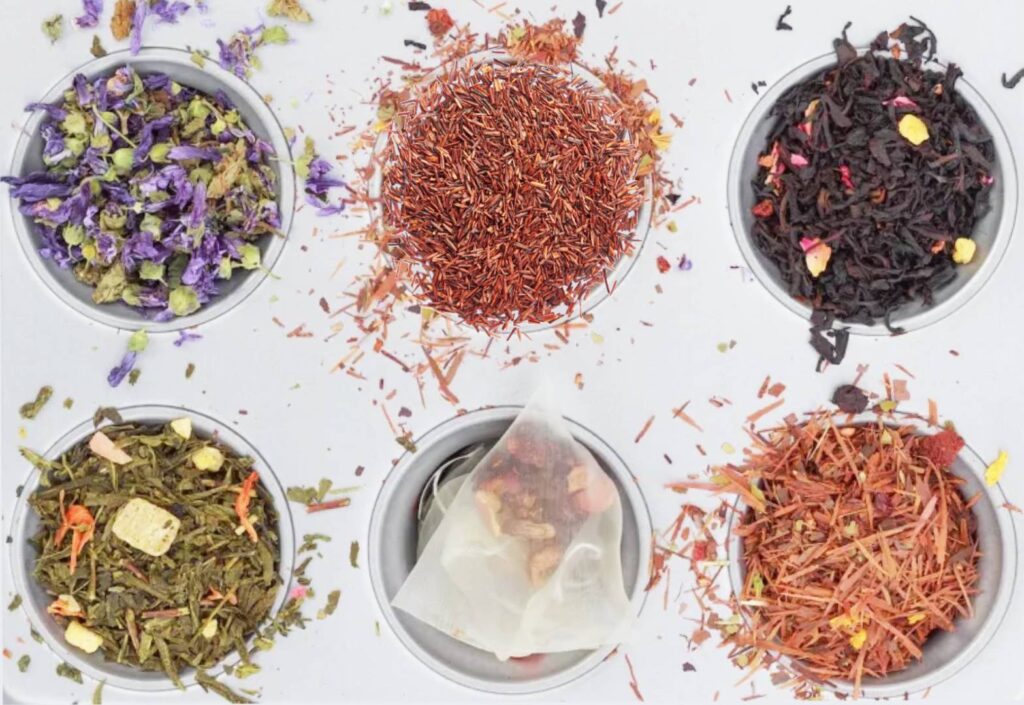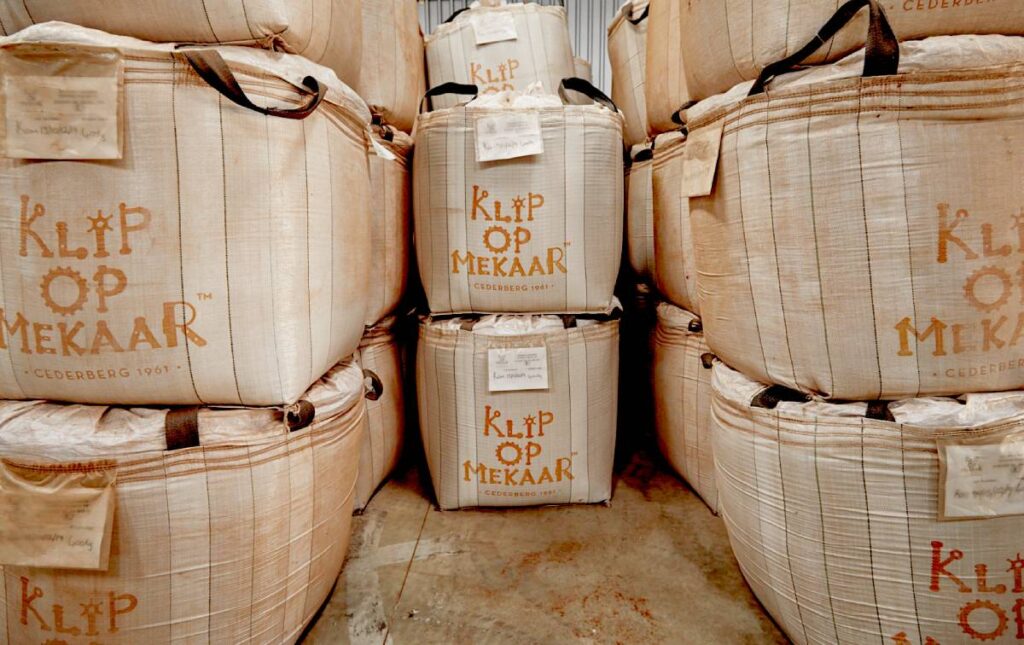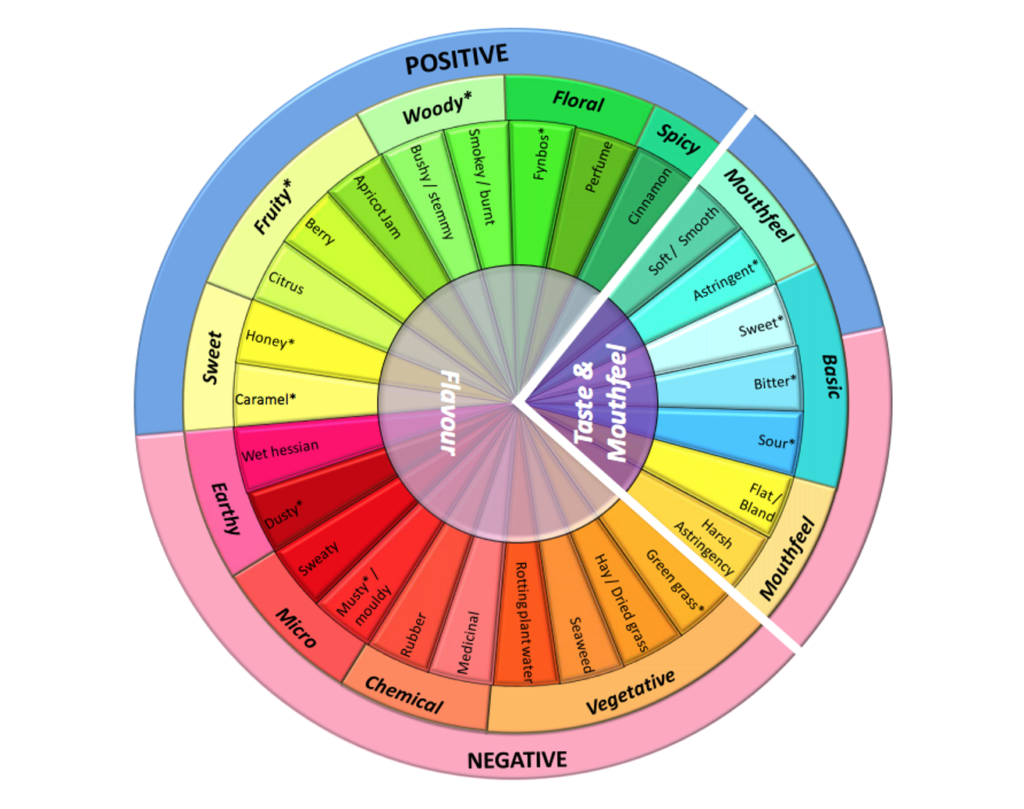As part of our ongoing series of articles that look into the use of rooibos as a herbal tea ingredient, this overview puts the spotlight on rooibos blend ingredients.
To provide tea and beverage brand owners with an overview of the ways in which rooibos meets the technical standards of tea blenders, as well as the interests of consumers, we answer the question “What are the common bulk rooibos blend ingredients used in the production of loose-leaf and packed teas, and what is the motivation for these blends?”
Rooibos as an ideal blend ingredient
To answer this question, we have performed an informal survey of the major tea houses and many leading tea brands, with a view to determining the prevalence of rooibos blend ingredients in the marketplace, and to shed light on the reasons that inform their formulation.
The results of our informal survey of rooibos blends on the global market have revealed that the majority of leading tea brands in the world have embraced rooibos. Evidence of this is that the vast majority of bulk blenders now feature rooibos as a standalone herbal tisane in their product ranges; some, for many years.
With this establishment of rooibos as a known quantity has come a familiarity that has led to interest in testing the compatibility of rooibos as a blend ingredient. This in turn has driven the emergence of rooibos blends, which have increasingly become available from blenders in recent years.
With a longstanding reputation as a caffeine-free herbal tea that has driven interest over recent decades, rooibos has long been a feature in the ranges of the world’s most prominent tea brands. For consumers, its health-giving properties and flavour profile are enough to drive a growth of interest in rooibos as a functional beverage as well as one with a taste that holds appeal.
However, for the world’s leading herbal houses that blend and process teas and herbal ingredients of all kinds, the motivation to make use of rooibos as a blend ingredient is a more expansive matter of technical specification and organoleptic properties.
That the indigenous herbal tea farmed by producers such as us at Klipopmekaar meets many of these criteria as an ideal blend component is evident in its rise as a key component found in a growing range of blends. Later in this article, we unpack that criteria to a greater degree in order to provide an understanding of how rooibos meets the rigorous standards that are applied at the bulk blending level. In addition, we outline how rooibos blends answer heightened consumer interest in functional beverages by providing a range of health benefits.
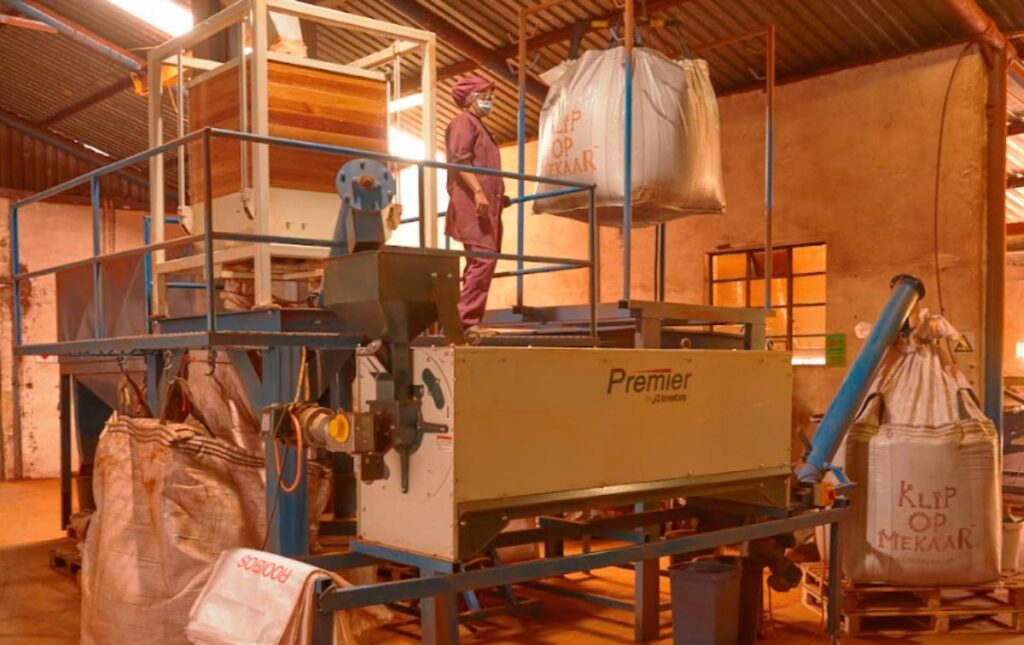
The role of German Herbal Houses as Bulk Blenders
As the largest importer, processor, and supplier of medicinal and aromatic plants in the world, it is in Germany that many of the world’s leading tea processors develop bulk blends and test the compatibility of herbal ingredients.
With a long history as a hub for tea importers that reaches back to the 1700s, the advancement of tea blending in Germany is very well established, and takes place in laboratory conditions that enable a highly refined and exacting selection process to be scientifically executed. It is within this context that herbal infusion ingredients are assessed for organoleptic, therapeutic and technical characteristics.
As outlined in our Rooibos Importers article on Germany, the majority of the world’s leading suppliers of blended bulk tea products being based in the country. This is why leading global tea and beverage brands turn to German suppliers when looking for new blend ingredients. This includes those that make use of rooibos as a blend ingredient with which other herbal and floral components are paired, as well as a wide variety of other herbal infusions.
As consumer interest in herbal teas has expanded in recent years to include a dizzying array of over 200 different types of herbs, spices and floral ingredients, so tea brands have sought blends from bulk suppliers that can meet this demand. Among the formulations offered are a growing range of products that include rooibos as a blend ingredient in combination with a variety of suitable pairings.
This overview thus includes a review of the major and minor rooibos blend ingredients offered by the biggest players in the blending industry, and investigates the motivation for their choice as blend components.
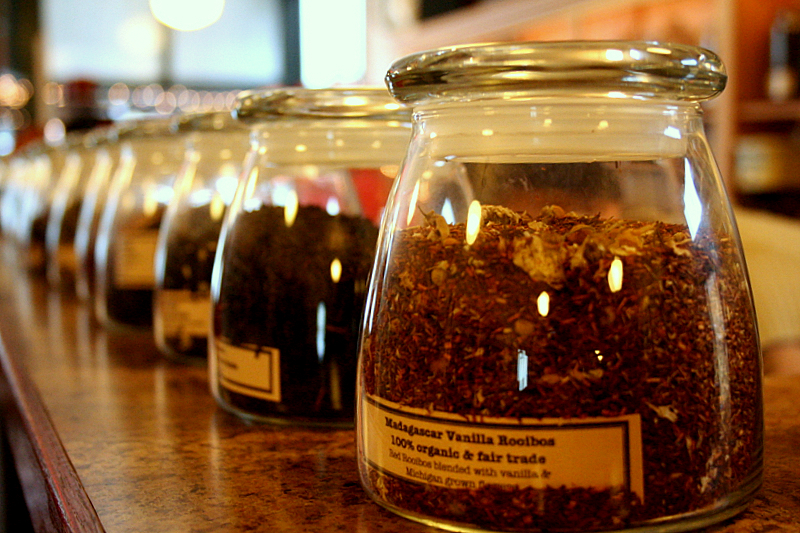
Major and Minor Rooibos Blend Components
Our investigation of the prevailing pairing of rooibos with other herbal, floral and fruit ingredients by bulk blenders has identified the most common combinations. These can be broken into the following two groupings of major and minor blends:
Major Rooibos Tea Blends:
Vanilla: A classic and widely popular blend, combining the sweetness of rooibos with creamy vanilla notes. Three major species of vanilla are grown globally, all of which derive from a species originally found in Mesoamerica, including parts of modern-day Mexico.
Chai Spices: Rooibos infused with traditional chai spices such as cinnamon, cardamom, and ginger for a warm and spiced flavour. Chai spices are those used in a popular tea beverage throughout South Asia, originating in the Indian subcontinent.
Citrus: These blends incorporate citrus flavours, like orange, lemon or mandarin, to add zesty and refreshing notes to rooibos. The genus Citrus is native to South Asia, East Asia, Southeast Asia, Melanesia, and Australia.
Berry: Blends that include various berries, such as strawberries, blueberries, or raspberries, providing fruity and slightly tart elements. Berry fruits consist of a wide range of species whose fruits are typically juicy, sweet, and tend toward red colouration.
Mint: Mint-infused rooibos, featuring either peppermint or spearmint, offer a cool and refreshing herbal tea. The mint family is found widely distributed across the world and has a long history of medicinal and culinary use.
Caramel: This popular sweet-tasting blend captures the essence of caramel, creating a dessert-like experience. Caramel is the orange-brown confectionery product made by heating a range of sugars.
Chocolate: These blends combine rooibos’s earthy notes with the richness of chocolate, delivering a delightful treat. Created from the pod of the cacao tree, chocolate is an unusual confection in that it is savoury in its pure form, but sweet when blended with other ingredients.
Coconut: The tropical flavour of coconut complements the nutty qualities of rooibos for a soothing and exotic infusion. Coconuts are the fruit of the coconut palm, which is found widely distributed across the tropics.
Earl Grey: Infusing rooibos with the citrusy and floral flavours of bergamot, reminiscent of traditional Earl Grey tea, creates a unique and aromatic blend. Research into the ancestral origins of citrus cultivars has found bergamot to be a probable hybrid of lemon and bitter orange.
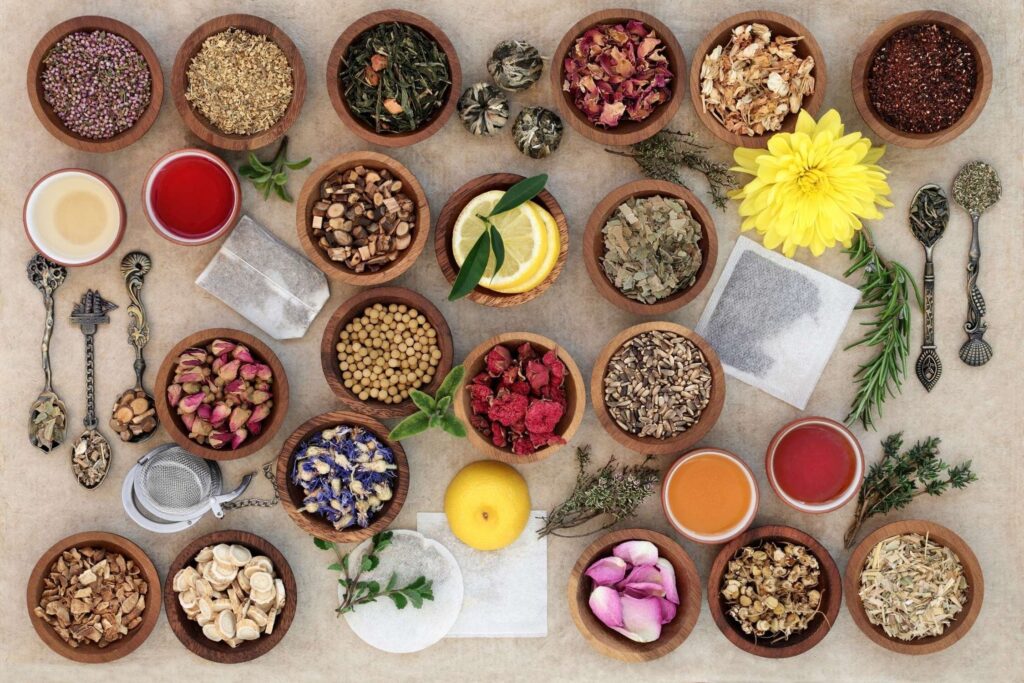
Minor Rooibos Tea Blends:
Honeybush: Combining rooibos with its close relative, honeybush, for a naturally sweet and fragrant herbal tea. Related to rooibos, honeybush is another herbal infusion that, like rooibos, is only grown in South Africa.
Lavender: The soothing aroma of lavender complements the rooibos, creating a calming blend. As a herbal calmative, lavender has a history of use that goes back over 2,500 years.
Almond: These blends incorporate the nutty essence of almonds for a subtle and slightly sweet profile. Almonds are the seed of a member of the Prunus family, specifically Prunus dulcis, which in Latin means ‘sweet plum’.
Rose: The addition of rose petals or flavour infuses rooibos with a floral and fragrant dimension. With the taste of rose being sweet with subtle undertones of fruit, this makes for a great pairing.
Lemongrass: Lemongrass adds a bright and citrusy note to rooibos, creating a refreshing infusion. Lemongrass is also known as Citronella and is found in Asia, Africa, Australia and tropical islands of the Indo-Pacific.
Pineapple: Blends with pineapple offer a sweet and tangy flavour to rooibos blends. Pineapple is the swollen multiple fruit of members of the Bromeliad family.
Blueberry: Blending blueberries with rooibos makes for a fruity and slightly tart tea experience. Blueberries are native to North America, and belong to the heath family of plants, known botanically as the Ericaceae.
Turmeric: These blends add earthy and slightly spicy turmeric to rooibos for potential health benefits, a unique taste, and a bold orange colour. Turmeric consists of the swollen rhizomes of a plant closely related to ginger.
Elderflower: The subtle floral and vanilla notes of elderflower enhance the overall aroma and taste of rooibos. Elderflowers come from the elder tree, Sambucus nigra, that generally grows as a shrub or small tree.
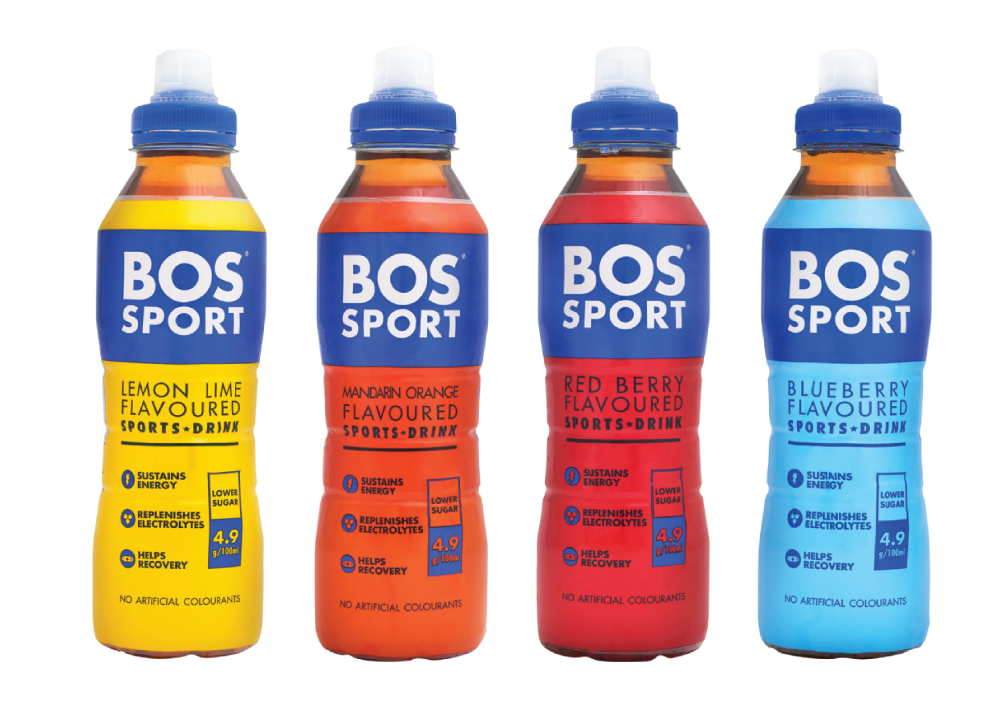
Rooibos blends in functional beverage categories
As global interest in health and wellness has continued to rise, so the demand by tea brands the world over for functional beverages over the last decade has grown. To meet this interest at the supplier level, bulk blenders have developed a variety of formulations related to energy, relaxation and health benefits. This has seen a growth in the range of rooibos blends becoming available to tea brands, and the promotion of these on the basis of a variety of benefits when consumed as a steeped tea, as a cold brew or as a ready-to-drink product.
However, herbal teas do not necessarily grow in volume as a stock-keeping unit on the basis of their functional benefits alone. Importantly, surveys by some of the leading German bulk tea processors and suppliers show that taste is the most important factor when developing functional foods and beverages.
With the requisite taste profile well-established, the usage of rooibos as a primary or secondary blend component in functional beverages is informed by the substantiation of its health-giving benefits. These have been detailed in a number of research papers that have been published over the last 20 years, during which interest in rooibos has spurred on investigation by the scientific community. This interest lies in validating the many anecdotal benefits that have long been a feature of the reputation of rooibos as a healthy alternative to black teas that may provide real benefits to consumers.
Primary amongst the compounds found in rooibos that have been confirmed to provide health and wellness benefits, or have a likelihood to do so, are those related to the polyphenol content of rooibos tea. These include flavanols, flavones, flavanones, dihydrochalcones, aspalathin, nothofagin and quercetin – each of which have been shown to provide a range of health benefits. Notably, rooibos tea is the only herbal infusion that contains aspalathin, a flavonoid which is extremely rare in the plant kingdom. It is only found in rooibos (Aspalathus linearis) and closely-related species.
With rooibos known to contain these beneficial polyphenols in addition to being caffeine-free, tea blenders consider it an ideal choice in the development of herbal infusion blends that provide functional benefits in a range of categories.

As the compatibility of rooibos with other herbal components has come to the fore in conjunction with research into its benefits, so the use of rooibos blends has diversified into a segmentation that corresponds to a specific set of functions.
Chief amongst these at this time are the following categories which are now offered by a wide variety of bulk blenders:
- Night-time/bed-time
Rooibos and Lavender
Motivation: Lavender is often used to promote relaxation and reduce stress, on account of well-known calming properties. Combining it with rooibos creates a soothing herbal tea that can aid in stress reduction and improve sleep quality.
Rooibos and Chamomile
Motivation: Chamomile tea has long been highly regarded for its calming and sleep-inducing properties. Blending it with rooibos provides a gentle and caffeine-free tea that’s ideal for promoting restful sleep and reducing stress.
- Kids
Rooibos and Honeybush
Motivation: Another South African herb similar to rooibos, honeybush has a mild, slightly sweet flavour. Blending with honeybush creates a kid-friendly, caffeine-free option that can be safely enjoyed by children.
Rooibos and fruit infusions
Motivation: The combination of rooibos with various fruit infusions such as apple, orange, or berries creates flavourful taste profiles of the type enjoyed by kids. Blends of this type are a delicious and healthy choice for kids.
- Health
Rooibos and Turmeric
Motivation: Turmeric contains curcumin, a compound with powerful anti-inflammatory and antioxidant properties. A turmeric blend can offer overall health benefits, including support for joint health and a robust immune system.
Rooibos and Ginger
Rooibos is rich in antioxidants, and ginger is well-regarded for its immune-boosting and anti-inflammatory properties. Combining rooibos with ginger creates a potent blend that can help support the immune system.
- Heart
Rooibos and Hibiscus
Motivation: Being rich in antioxidants, hibiscus has been linked to potential benefits for heart health, including supporting healthy blood pressure. When combined with rooibos, this blend presents a heart-healthy choice to consumers.
Rooibos and Cinnamon
Motivation: Cinnamon is known for its potential to help regulate blood sugar levels and support cardiovascular health. Rooibos and cinnamon create a flavourful blend that may contribute to overall heart health.
- Sport
Rooibos and Peppermint
Motivation: Peppermint is known for its digestive benefits, and a rooibos and peppermint blend can be a refreshing and soothing option after a workout, supporting digestion and overall well-being.
Rooibos and Green Tea
Motivation: Green tea contains caffeine and antioxidants that can provide an energy boost. Blending it with rooibos creates a balanced sports drink with antioxidants for recovery and a moderate caffeine content for energy.
As research into the variety of compounds found in rooibos continues, there is potential for these categories to expand as new benefits are verified, and blend pairings are considered where other herbal components may offer similar or complementary effects. Adding to this potential would be the sensory compatibility of rooibos and blend partners, which we address below.
Sensory compatibility: Rooibos as a blend ingredient for all tastes
As consumer demand has grown a range of herbal teas that include a wide range of components sought after for their taste and overall sensory appeal, so interest from brands in meeting this has grown. Motivated by a need to present consumers with innovative herbal tea products, brands have turned to their bulk suppliers to obtain formulations that include a wide range of herbal infusions, including rooibos.
Rooibos has a taste profile that sits in the sweet and mild zone. This means it stands out prominently as satisfying blender’s interest in a primary component that lends itself not only to being suitable in answering a need for a tasty beverage, but also one suitable to being used as a base flavour with which appealing blends can be created.
Over time, rooibos has earned a reputation amongst bulk blenders as a very good base and carrier ingredient. This is because its characteristics lend itself to carrying other herbal ingredients – but the opposite is not true, ie: it is unusual to find other teas carrying rooibos as a blend flavour. In addition, rooibos is not a dominant taste – in other words, it balances well with other herbal infusions and handles the addition of other components exceptionally well.
In this context what is typically seen is that rooibos is the base carrier of the balance of other material ingredients. This includes a wide array of interesting and exotic blended items – and in particular, it acts as a great carrier for fruit flavours. This is the reason for rooibos emerging as a widely-used carrier in dry tea blends (ie: tea bagged and loose leaf blends), and in recent years, has increasingly found utility as a base ingredient in ready-to-drink (RTD) beverages.
With its pairing or carrying capacity well established, another strong motivation for rooibos as a blend ingredient being used in this way is that it naturally adds sweetness to a blend, without the need for additional sweeteners of any kind.
Having this naturally sweet taste profile – significantly sweeter than black tea – is what has helped distinguish rooibos from the vast majority of other herbal infusion ingredients on the market.
In a world where people are watching their waistline by avoiding products with added sugar or sweeteners, these aspects of rooibos have been the reason that it is now favoured by so many bulk blenders, and is sought out by leading tea brands.
Practical and Technical suitability: Rooibos ticks all the boxes
In the pursuit of identifying an ideal balance of components for the creation of herbal infusion pairings, blenders assess these using a range of criteria related to the practical and technical aspects of each.
In terms of the practical, certain characteristics of black tea are considered as a guideline to the ease with which consumers can prepare and enjoy any tea product. With the steeping of tea, whether in bagged tea or as a loose leaf preparation, this necessarily involves components being suitable as far as rapidly and easily ‘brewing’ to create a beverage.
Any complications related to the common practice of preparing tea would be considered a downside; happily, rooibos as a blend ingredient ticks this important box, with its preparation being precisely the same as black tea. But this is not the only characteristic to which blenders will look: beyond ease of preparation, there are other important factors to consider. Among these are its compatibility with milk – and again, this is an area in which rooibos stands up very well, with it being the only herbal infusion that goes really well with milk (as well as being perfectly suitable when used without).
These practical aspects are factors assessed when bulk blenders consider the viability of herbal infusion blends as a marketable product for their customers, who are tea brands and beverage companies. However, when looking to blend components at the bulk level, other determinations must be made – and these are the critical technical aspects of any tea blend component that are related to the processing of bulk ingredients, and the machinery with which these are created.
These technical criteria are those which affect the flowability of any bulk ingredient through a blending plant’s production facility, and its suitability as a stable ingredient when packed – in tea bags, as loose leaf, or in bulk storage. This is again an area where rooibos stacks up well, with primary processing of rooibos at farm level having advanced and been refined over the last 30 years to produce a stable and consistently-sized product.
When supplied in bulk by a primary processor to a well-established secondary processing partner for sifting, sterilisation and pre-shipping packing, rooibos undergoes a variety of steps to ensure it meets specifications set by end buyers and those required by agricultural export regulations. Importantly as part of this movement through the supply chain, moisture content is constantly monitored in order to verify that no moulds or pathogens might contaminate the bulk product.
The monitoring of moisture content initially takes place on the tea court, where it is dried in the heat of summer in the region where it is harvested, the Cederberg area of South Africa. The product is then again tested for moisture content when it is put through the various stages involved in secondary processing.
Ultimately – and in line with the specifications required to be met by the end-buyer – the moisture content of rooibos should not exceed 10%, in order to ship and store well under the correct conditions. In this area, rooibos as a blend ingredient once again ticks a very important box.
When stored appropriately in food-safe warehouse conditions, the shelf life of rooibos exceeds 5 years, and experienced rooibos farmers report that when stored in stable circumstances, the flavour profile improves beyond 5 years. During this time, moisture content remains steady – another important consideration when blenders at the bulk level are looking for reliability and consistency in their stock of herbal ingredients.
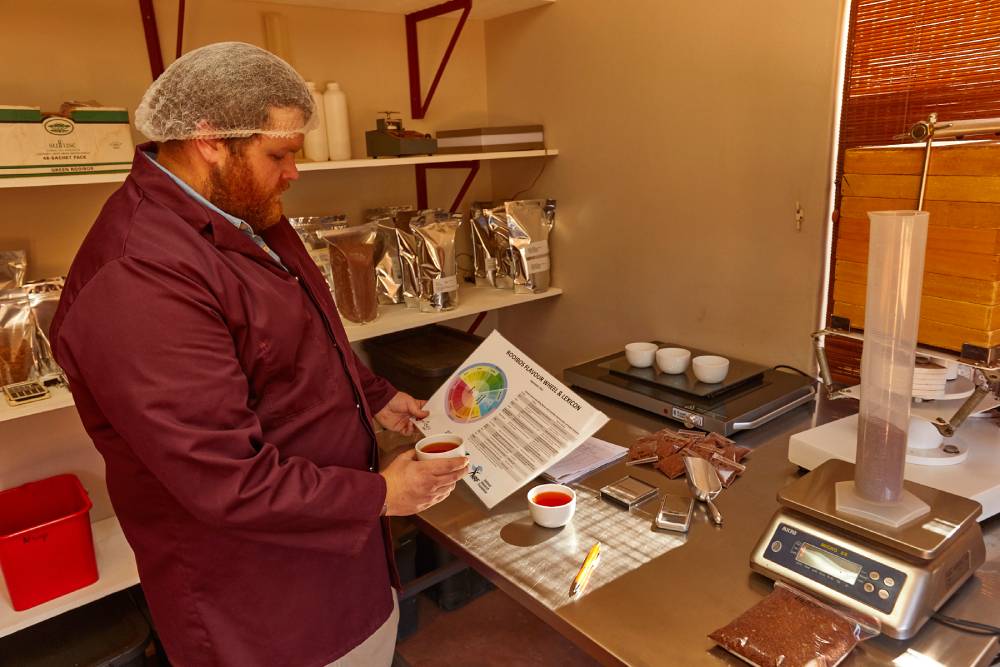
Technical Properties:
Particle Size: The size of tea leaves or herbal ingredients can affect the rate of infusion and brewing time, with smaller particles typically brewing faster than larger ones. Short Cut rooibos is ideal for blending with fine particle materials in teabags – and Long Cut rooibos is typically blended with larger items such as fruit which are used in Loose Leaf blends. With a growing market appetite for loose leaf blends consisting of herbal and flavour components, the use of rooibos as a blend ingredient aligns well with growing global trends in this area.
Colour: The colour of tea leaves or herbal ingredients can vary widely. In assessing and identifying herbal ingredients for blending with rooibos, colour will be among the leading reasons for selection, as rooibos itself exhibits a palette between amber and brick red. Compatibility with this colour range is key, and is among the primary reasons that rooibos has risen to prominence on the back of its utility in providing both a base flavour and a base colour.
This red-spectrum colour lends itself to pairing with a wide range of herbal partners whose own colouring adds a tone to the blend, and is increasingly a driving factor in rooibos being used as a RTD foundation in a range of beverages that are bright red or orange.
Density: Bulk density of rooibos (ie: weight per mass) can affect flowability in packing machines. Expert producers such as Klipopmekaar can create relatively higher bulk density rooibos than the majority of product found in the market. However, that being said, when it comes to blends of Long Cut and loose leaf rooibos, bulk density is less of an issue as the product is not being packed into teabags.
Moisture Content: The moisture content of tea leaves or herbs is crucial for storage and preservation. High moisture levels can lead to spoilage or mould growth, while excessively dry ingredients can affect flavour. All rooibos is stored and exported at a moisture content below 10%, providing a long shelf life, and the product’s taste profile can generally improve slightly when stored appropriately over the long term.
Caffeine: The caffeine content can vary among different types of tea and herbal ingredients. Some people prefer teas with lower caffeine levels for various reasons, including health considerations. Being caffeine-free, rooibos has increasingly been chosen as the base ingredient in a wide range of offerings that are suitable for children and consumers looking for a night-time or bed-time beverage.
Purity: The absence of foreign matter, such as twigs, stems, dust, or other impurities, is important for the quality of tea ingredients. In the processing of rooibos the product goes through a variety of stages that include sieving and Pasteurisation, which ensures the absence of foreign matter, in line with global food safety specifications and standards such as FSSC 22000.
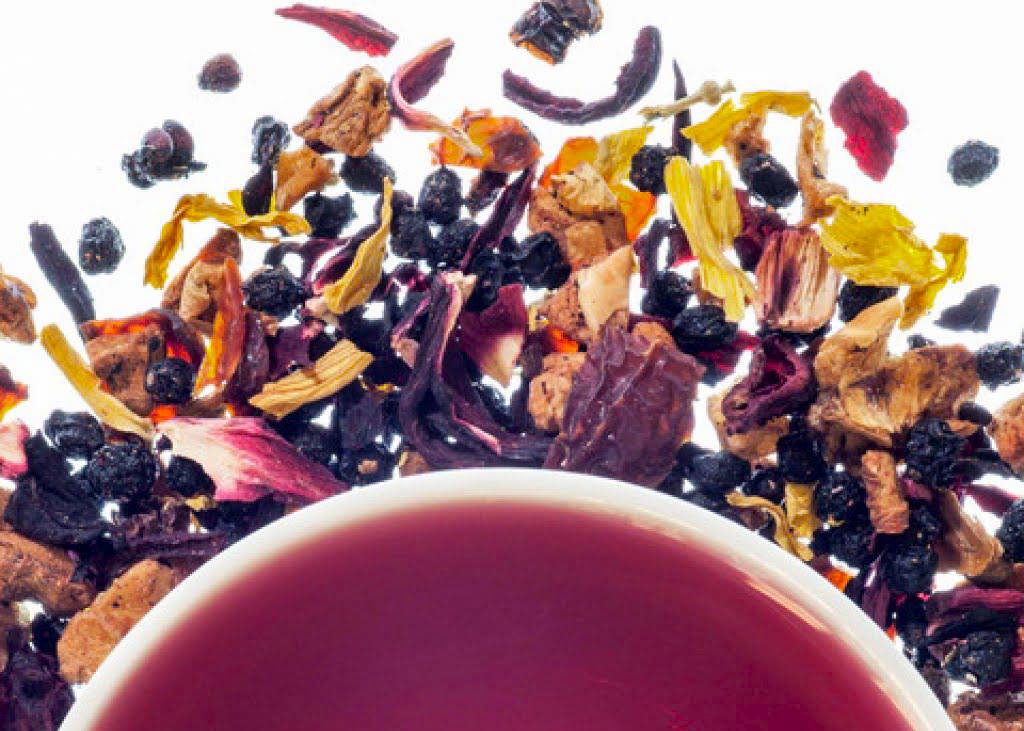
The future: forecasting for trends in blends
With rooibos blends having matured from being a relatively peripheral product in terms of bulk blenders and their customers in the 1990s to the present time, where the vast majority of leading tea brands carry a wide range of them, a diverse range of products have come onto the global marketplace.
That these have segmented to match interest in specific benefits and flavours points the way forward. As the compatibility of rooibos as a blend ingredient with herbal, floral and fruit partners is explored by bulk tea blenders and tea brands alike, so inventive new pairings continue to be developed.
Among the most interesting innovations in blends are those making use of ingredients that are relatively novel in herbal teas, yet offer a good combination of flavour. Examples of these are yuzu (a Japanese citrus) and also kiwifruit – both of which provide a sweet and sour taste that balances well with rooibos’ mild floral profile. In the area of functional benefits, new blends are being seen which contain moringa, which is highly nutritious, and also marigold petals, which have well-established anti-inflammatory properties.
In line with the organoleptic compatibility detailed above, new blends are coming to market that are paired on the basis of colour and flavour. In this respect the exploration of red- and orange-coloured fruits makes sense, and has led to new combinations that are seeing rooibos matched with goji berry, pomegranate and loganberry.
Perhaps the most unusual pairing that our investigation of rooibos bulk blends has unearthed is that of rooibos and cascara, or coffee cherries. As a byproduct of coffee bean production usually used in animal feed, coffee berry pulp can be steeped to create a sweet and aromatic beverage. Having a naturally dark red colour, it makes for a logical pairing partner with rooibos as a blend ingredient – though these blends would of course still contain caffeine.
What is certain is that the innovation that has seen rooibos blended at bulk volumes with a wide number of suitable herbal and floral components in the past shows no sign of slowing down. If anything, experimentation and invention looks set to advance and grow, pointing to a new and viable expansion in the herbal tea and infusion market.
Driving this inventiveness is the globalised nature of world trade: as interesting and novel herbs and fruits from all parts of the globe become more well-known, so inevitably these will continue to be weighed up in terms of their suitability in tea blends. This bodes well for rooibos as a blend ingredient, being as it is a highly versatile blend candidate for the reasons outlined above.
With this versatility having been well established for some time in the global bulk blend market, and this in turn seeing new beverage formulations being brought to market by bulk blenders, the future looks promising for rooibos blends. Driven by consumer interest and the growing body of evidence that rooibos provides significant functional benefits, it could reasonably be anticipated that its place in the global marketplace is secure, and shows signs of continuing to gain ground and shelf space.
This article is the latest in a series designed to provide tea industry buyers and brands with accessible and comprehensive reference material on rooibos tea. For further overviews of various aspects of the rooibos tea industry and rooibos as a herbal tisane, see these other articles here on our website:

